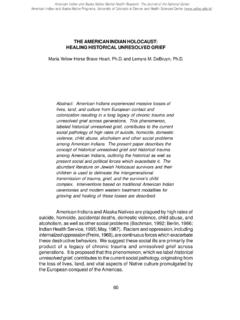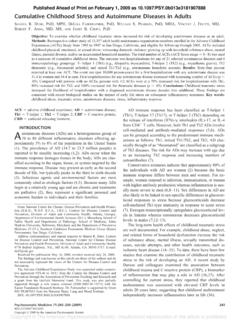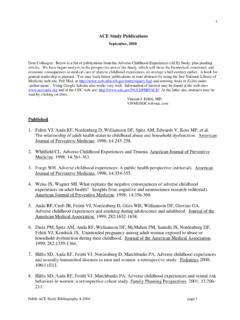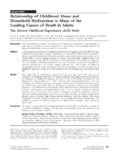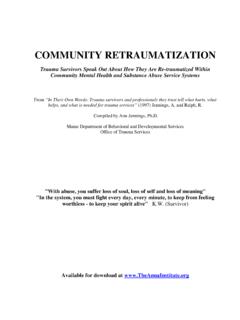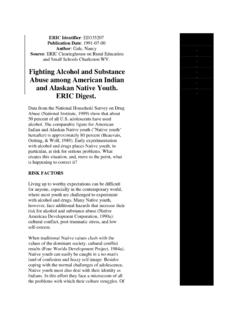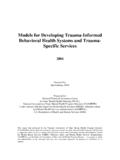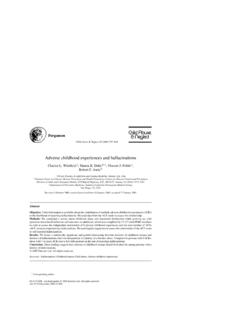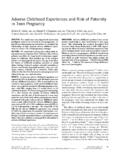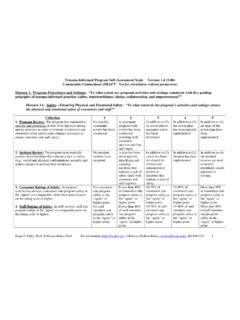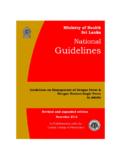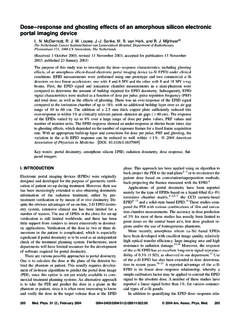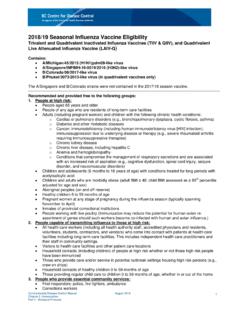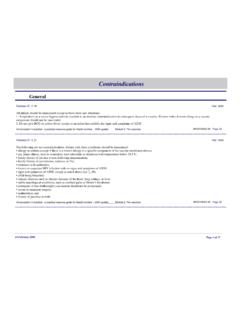Transcription of Building a Framework for Global Surveillance of the …
1 Building a Framework for GlobalSurveillance of the Public HealthImplications of AdverseChildhood ExperiencesRobert F. Anda, MD, MS, Alexander Butchart, PhD, Vincent J. Felitti, MD,David W. Brown, DSc, MScPH, MScBackgroundIn May 2009, the WHO and the National Center forChronic Disease Prevention and health Promotion(CDC, Atlanta GA) met in Geneva, Switzerland, tobegin a collaborative effort to build a Framework for pub-lic health Surveillance that can be used to def ne the globalhealth burden of adverse childhood experiences (ACEs).In addition to WHO and CDC staff, meeting participantsincluded people working in the f elds of public health andearly child development from Canada, China, the formerYugoslav Republic of Macedonia, Philippines, Saudi Ara-bia, South Africa, Switzerland, and Thailand.
2 Participantsarticulated their goal of forming a network aimed at ad-vancing Global understanding and measurement of ACEsthrough the exchange of information and the provision oftechnical expertise and child maltreatment and related experiences asa set of exposures that have broad implications for humandevelopment and prevention of public health problems isa relatively new concept. Only since 2004 has child sexualabuse been included in the Global burden of disease esti-mates of death and disability attributable to particularavoidable risk factors,2and medical journals have re-cently begun to acknowledge the concept of abuse andrelated it as a major public health issue by raising aware-ness of the body of literature that supports this ,4 Why adverse childhood Experiences?
3 We use the termadverse childhood experiences(ACEs) asa way of moving toward understanding thepublic healthimplications of childhood maltreatment and related experi-ences. The experiences referred to herein include (butshould not be conceptually limited to) abuse (emotional,physical, sexual); neglect (emotional, physical); andgrow-ing up in households where domestic violence is wit-nessed, members abuse alcohol or drugs or have mentalillnesses, there is relational stress (such as separation ordivorce), or members exhibit criminal behaviors. An im-portant recommendation from the May 2009 expert con-sultation in Geneva was to expand these sets of experi-ences to include the ACEs that occur in both developingand developed nations.
4 Specif cally, to ensure that thecontributions of criminality and organized violence tochildhood adversity are adequately addressed, additionalquestions on forced marriage, witnessing criminal andcollective violence in the community, and early conscrip-tion were added. Acknowledging that other children canbe a notable source of adversity, exposure to bullying,other forms of peer-to-peer violence, and sibling physicaland emotional violence were also added. Expansion of thesets of experiences not only adds new concepts and mea-sures to consider but also requires thought on the rela-tionships among multiple social dimensions that may choice of terminology and measures of childhoodexperience is largely based on the f ndings from the ACES tudy, an ongoing collaboration between CDC and Kai-ser Permanente (San Diego CA).
5 The present study com-bines retrospective reports of ACEs at baseline and pro-spective follow-up of the study cohort to examine theprevalence and incidence of diseases, healthcare utiliza-tion, premature mortality, and causes of 8 Table 1summarizes the breadth of the published f 2008, the CDC developed questions similar to thoseused in the ACE Study for incorporation into the behav-ioral risk factor Surveillance system (BRFSS). The BRFSSFrom Carter Consulting Inc. (Anda); Emerging Investigations and AnalyticMethods Branch, Division of Adult and Community health , NationalCenter for Chronic Disease Prevention and health Promotion (Brown),CDC, Atlanta, Georgia; Department of Injuries and Violence Prevention,Noncommunicable Diseases and Mental health (Butchart), WHO, Ge-neva, Switzerland; Department of Preventive Medicine, Kaiser Permanente(Felitti), San Diego, CaliforniaAddress correspondence to: Robert F.
6 Anda, MD, MS, CDC, 4770 Bu-ford Highway NE, MS K67, Atlanta GA 30341. 2010 American Journal of Preventive Medicine Published by Elsevier J Prev Med 2010;39(1)93 9893is the largest ongoing health survey in the world and hasproved useful to def ne the prevalence of health behaviorsand other determinants of health in the (in 2009), f ve state health departments are using thesequestions ( ) in their BRFSS to determine the preva-lence of ACEs and their relationship to major publichealth problems. The states, funded by the CDC to collectthese new data, were chosen because of their sociodemo-graphic diversity. Initial f ndings from ACE BRFSS datawill be available in winter/spring of 2010.
7 Additionalstates will be collecting ACE data in 2010. The BRFSSACE data will serve as a frame of reference for construct-ing similar measures in other ACE Concept and Primary PreventionThe emergence of ACEs as topic of research in publichealth is a natural evolution in the f eld of health promo-tion and disease prevention. This brief background pro-vides a short historical and conceptual Framework forunderstanding this seminal work of McGinnis and Foege, titled Ac-tual Causes of Death in the United States, 11quantif edthe contribution of alcohol, smoking, and other healthrisk behaviors to mortality in the In addition, thegrowth in popularity of the BRFSS10as a tool to monitorthe prevalence of health -related behaviors reflects themomentum generated by studies documenting the influ-ence of behavior on health .
8 However, these importantsources of health information do not tell uswhythebehaviors are Surgeon General s Report on Smoking andHealth12and the attendant decline in the prevalence ofsmoking over the ensuing decades provide an example ofboth the success and shortcomings of health informationand promotion campaigns. The success is obvious, but ifinformation about the risk of smoking was suff cient, whydo so many Americans continue to smoke?13 And why isthe prevalence of smoking so high in developed countriesin Europe and Asia?14If the addictive properties ofnicotine are the major determinant of continued smok-ing, why can some smokers quit whereas others cannot?
9 A partial explanation for the latter questions can be foundin the evidence linking depression a common noncog-nitive factor in many people s lives to smoking. Peoplewho are depressed are more likely to be smokers, andwhen followed prospectively, have been less likely ,16A convincing explanation for this f nding is thatthe properties of nicotine that reduce anxiety and de-pressed affect lead to the use of cigarettes as a logical, butprobably unconscious, adaptation to depression. Affectregulation is an important human capacity; apparentlydepressed people will use smoking as an adaptive re-sponse to facilitate this capacity despite the negativewell-known long-term health this example illustrates, cognitive approaches tobehavioral change are limited.
10 In this paradigm, what istheactualcause of death for depressed smokers dyingfrom emphysema? Is it smoking or depression?Whyarethey depressed? These questions represented the scien-tif c gap in understanding the root origins of commonhealth risk factors that the ACE Study and social problems and the ACE scoreProblems from thebaseline dataOutcomes associated withthe ACE scorePrevalent diseasesIschemic heart disease, cancer,chronic lung disease, skeletalfractures, sexuallytransmitted diseases, liverdiseaseRisk factors for commondiseases/poor healthSmoking, alcohol abuse,promiscuity, obesity, illicitdrug use, injection drug use,multiple somatic symptoms,poor self-rated health , highperceived risk of AIDSM ental healthDepressive disorders, anxiety,hallucinations, panicreactions.
